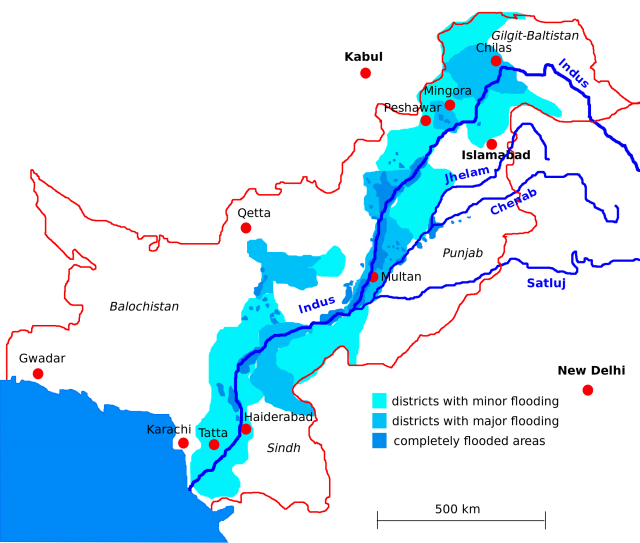Indus River
THE INDUS RIVER in PAKISTAN flows 1,900 mi (3,000 km) from southwestern TIBET to the Arabian Sea. From the dawn of human culture, the Indus River has sustained societies along its banks; the earliest civilization that can be reliably distinguished is called the Indus Valley civilization (or Harappan). This sophisticated society is dated back to 2500 B.C.E. The Harappan culture was a well organized civilization built upon surplus agricultural production and bolstered by commerce that reached as far Mesopotamia. The nascent agricultural predecessors of the Harappan culture may well reach back into the 5th millennium B.C.E.
The name Indus comes from its Sanskrit name sindhu (meaning “water, flood, ocean”). The drainage basin of this great river has caught a continuous stream of invaders and conquerors of various ethnic, inguistic, and religious origins. Each of these succeeding groups would wind their way through the mountain barriers and flow down toward the Indus River seeking purchase in its fertile valley. The records of these peoples come to us through spoken and literary traditions that reach back without break to 2000 B.C.E. The Vedas are a uniquely ancient traditional history that tells us of the Aryan tribal groups of pantheistic pastoralists that supplanted the earlier Harappan culture. This pattern of migration, conquest, and decline would repeat itself over the centuries to follow.

Alexander the Great brought his conquering army to the Indus around 326 B.C.E. and left a lasting impression of Hellenist culture in art of the region. This influence survives in the great Buddhist statuary art treasures that grace the Indus Valley. Buddhism gained dominance with the coming of Ashoka (236 B.C.E.) and his turning of Taxila into a major Buddhist center of learning and culture. The ebb and flow of empires continued with rulers from the east and west vying for control. Buddhist, resurgent Hindu, and then Islamic conquerors ruled until the passing of time brought 15th century Europeans to the Indus River.
The British came as all conquerors before them, but were the first to seek to subdue the Indus River as well as its people. They spent 100 years attempting to harness the irrigation power of the waters. This radically changed the landscape and impacted social and political structures, changes that continue today. The dams and barrages built by the British remain the primary infrastructure to fight annual flooding.
The Indus River shares all the challenges that accrue with major man-made improvements. Dams reduce flows in lower portions of the system and limit the transport of fertile sediments downstream into the DELTA. Dams compartmentalize river systems and isolate aquatic life into smaller communities. Extraction of irrigation water, especially during low water periods can threaten fish stocks. Introduced species often compete with indigenous ones.
Density of population along the Indus and its tributaries combined with an almost total lack of conventional public sanitation systems mean many water courses are little more than sewage carriers at low flow periods. This leads directly to the contamination of drinking water and agricultural produce. Low-lying land is commonly used as solid waste dumping sites contributing to illness and mortality. The vaunted “green revolution” has brought increased food production but also introduced large quantities of fertilizers and pesticides into the waters and sediments of the Indus. Growth of the textile industry and other manufacturing has radically increased the flow of toxic industrial wastes into the riparian system. Pakistan is only in the earliest stages of studying and addressing the sustainment needs of the Indus River.
The head of the Indus rises in southwestern Tibet. It then flows northwest through Kashmir before bending to the south and leaving the mountains to become a slow-flowing, highly braided river course. It is dammed near Peshawar to form the Tarbela Reservoir. The catchment area of the Indus is estimated at almost 386,100 square mi (1 million square km), and all of Pakistan's major rivers flow into it. In its upper basin of Punjab (meaning “land of five waters”) are the Jhelum, Chenab, Ravi, and Sutlej rivers. Passing by Hyderabad, it ends in a large delta to the southeast of KARACHI.